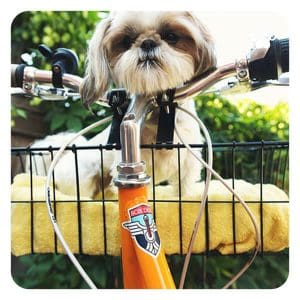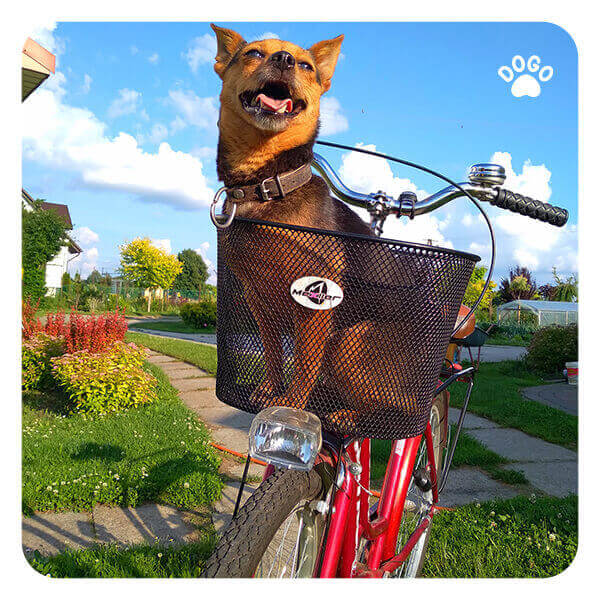 You take your dog out on several walks, hikes, along with bringing them to doggy playdates, but if these activities are not sufficient enough for your high-energy dog, biking might be the way to go! Riding your bicycle while having your dog run alongside you is a fun and exciting way to bond with your pup, and it is a healthy activity for both of you! Read how to safely take your dog on a bike ride.
You take your dog out on several walks, hikes, along with bringing them to doggy playdates, but if these activities are not sufficient enough for your high-energy dog, biking might be the way to go! Riding your bicycle while having your dog run alongside you is a fun and exciting way to bond with your pup, and it is a healthy activity for both of you! Read how to safely take your dog on a bike ride.
Vet Exam Before Bike Ride
Although your dog may appear to be healthy, it is recommended to bring them to your veterinarian to check for any underlying health conditions before starting any new exercise regimen. This is especially important if your dog is a senior or has a pre-existing medical condition. Your vet can advise you on what activities would be suitable for your dog and how to gradually introduce them. They can also help you identify any potential health risks that may arise during exercise and how to manage them. Remember, prevention is always better than cure, and taking your dog for regular check-ups can help ensure they stay healthy and happy.
Slow Introduction
Some dogs feel completely fine around a bike whereas others are nervous and fearful of it because of the sounds and movement; if your dog is one of them then it is best to train and warm them up to be comfortable around the bike before expecting to go on a long ride. Always use positive reinforcement, enthusiastic praise, and bring out high-value treats during your initial training and for all riding experiences.
Ready to Try?
- First, allow your dog to walk up to the bike while it is parked and stationary. If your dog is sniffing the bike and remaining calm, feed high-value treats to create a positive association. You can lay your bike down on the ground and make it a fun game by playing with your dog and placing treats on the tires, the frame, and the pedals.
- Start to move the wheels around and let your dog see the movements, and give treats.
- Once your dog is comfortable with this step, then start to walk with your dog on a leash and move the bike at a slow pace and get them to see that it can make left and right turns. Reward your dog for being calm and if they keep their attention on you.
- Then, clip on your dog’s specialty bike leash and start riding the bike slowly. Begin with about 10 minutes at a slow to moderate pace and add 5 to 10 minutes to the ride every few days.
- Always check your dog’s health and only increase the time if you feel your dog can tolerate it and if they have the endurance for it. If you see your dog is slowing down, they will need rest, or it may be time to head back home.
In addition, teach your pup some cues such as “Slow,” “Stop,” “Easy,” “Turn,” “Leave It,” which are some behaviors you will need your dog to perform during the ride.
Choosing Safe Dog Biking Gear
 There are several hands-free dog specialty bike leashes and harnesses on the market that keep you and your dog safe while riding. One of the advantages of the specialty bike leashes is that it attaches directly to your bike’s frame, allowing you to keep both hands on the bike while allowing your dog to be at a safe distance from the wheels while in motion. Another advantage is it minimizes the chances of your dog tugging and getting into accidents. Holding a traditional leash in your hands like you would for a routine walk can be troublesome and dangerous, especially if your dog has a prey drive and will want to chase after a squirrel! In addition to the specialty bike leash, it will help to put a reflective harness on your dog to improve your dog’s visibility at night.
There are several hands-free dog specialty bike leashes and harnesses on the market that keep you and your dog safe while riding. One of the advantages of the specialty bike leashes is that it attaches directly to your bike’s frame, allowing you to keep both hands on the bike while allowing your dog to be at a safe distance from the wheels while in motion. Another advantage is it minimizes the chances of your dog tugging and getting into accidents. Holding a traditional leash in your hands like you would for a routine walk can be troublesome and dangerous, especially if your dog has a prey drive and will want to chase after a squirrel! In addition to the specialty bike leash, it will help to put a reflective harness on your dog to improve your dog’s visibility at night.
When selecting dog biking gear, it’s important to choose items that fit your dog properly and are comfortable for them to wear. Ill-fitting gear can cause rubbing, chafing, and discomfort, which can make your dog resistant to wearing it. Look for gear that is adjustable and comes in a range of sizes to ensure a proper fit. Additionally, it’s important to check the gear regularly for signs of wear and tear, such as fraying or broken clasps. This can compromise the safety of the gear and put your dog at risk of injury. Finally, when using a bike trailer or carrier, make sure it is secured tightly to your bike and that your dog is properly secured within it. A loose or improperly secured trailer can easily tip over, causing injury to your dog and potentially to you as well. By taking the time to select and maintain safe and comfortable gear, you can help ensure a safe and enjoyable biking experience for both you and your furry friend.
Extra Supplies
You will need to carry a small pet first aid kit, an adequate amount of water, dog treats and snacks, an extra dog leash for when your dog is not attached to the bike, and a helmet for yourself to keep you safe.
Bike Trailers and Baskets
 Not every dog is suitable or ecstatic about the idea of running alongside a bicycle. Some senior and overweight dogs have a more challenging time with strenuous exercises due to their degenerative joint disease or arthritis. The same goes for puppies, where strenuous exercise can affect their bone growth. Brachycephalic breeds or short muzzle dogs such as Pugs, Boston Terriers, Shih Tzus, or French Bulldogs have difficulty breathing and cannot cool down their temperature normally, so rigorous exercises are usually not recommended. However, there are other ways for your dog to enjoy a bike ride with you. Consider putting your dog (if under 20 pounds) inside a specialty bike basket so you can ride with your dog without having to worry about them being able to keep up with you. Another substantial option for larger dogs is a bike trailer or carrier that attaches to the back of your bicycle. Dog-friendly bike trailers have built-in harness systems to prevent your dog from jumping out, and some are designed with a cover for sheltering your dog during hot or inclement weather.
Not every dog is suitable or ecstatic about the idea of running alongside a bicycle. Some senior and overweight dogs have a more challenging time with strenuous exercises due to their degenerative joint disease or arthritis. The same goes for puppies, where strenuous exercise can affect their bone growth. Brachycephalic breeds or short muzzle dogs such as Pugs, Boston Terriers, Shih Tzus, or French Bulldogs have difficulty breathing and cannot cool down their temperature normally, so rigorous exercises are usually not recommended. However, there are other ways for your dog to enjoy a bike ride with you. Consider putting your dog (if under 20 pounds) inside a specialty bike basket so you can ride with your dog without having to worry about them being able to keep up with you. Another substantial option for larger dogs is a bike trailer or carrier that attaches to the back of your bicycle. Dog-friendly bike trailers have built-in harness systems to prevent your dog from jumping out, and some are designed with a cover for sheltering your dog during hot or inclement weather.
Safety First
Be aware of asphalt and rough terrain and ride on soft paths, such as grassy or dirt roads. Riding on rough terrain paths can damage your dog’s paw pads which can cause discomfort and pain. Choosing to ride in quieter neighborhoods on certain days and times is often a better choice than riding with your dog on roads with heavy traffic, which can be dangerous. If you choose to go mountain biking with your dog, be aware of the different surfaces that the trails can have. Avoid riding on hot summer days to prevent your dog from suffering from heat exhaustion or in the cold winters to prevent hypothermia. Not all dogs like wearing dog booties, but you can consider putting them on to protect your dog’s paw pads from the hot roads, icy roads, or sharp objects on the ground.
Enjoy the Journey Together!
Whether your dog is running happily alongside you while you ride, seated in a doggy basket while feeling the wind on their face, or enjoying the scenery while being towed along in a trailer, they are all ways for your dog to experience an exhilarating adventure with you!
[/fusion_text]



